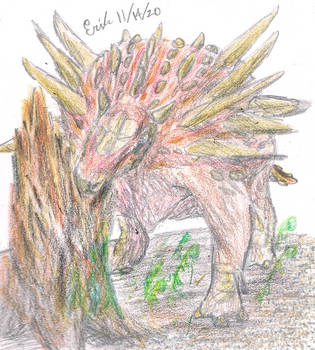ShopDreamUp AI ArtDreamUp
Deviation Actions
Problem:
Many predators protect their teeth from corrosion caused by air using lips, yet there was a new study published stating theropod dinosaurs from the tyrannosaurid family do not appear to have had them.
Short answer:
No lips anymore.
Long answer:
First of all the new discovery. The researchers certainly haven't put the claim "no lips" in the title... I know this isn't a strong argument just sain'
Secondly: using living relatives and a nearly realated group. Both living relatives, birds and crocodiles, do not have lips. Bird have toothless beaks, not in the need of protecting any teeth, and crocodiles simply don't have lips, being semi-aquatic creatures. However, there is a group of mostly carnivorous, fairly near realated creatures which do have snouts as well as beaks, and teeth in both of them: pterosaurs. We found soft tissue in all forms and shapes on them, from pulmonary airsacs to wing membranes, fuzzy integument and even head crests with preserved colouration, yet we found not one of them with lips, but even contrary: Pterodactylus shows teeth as well as a ceratinous sheath, not protecting the teeth, even though it was a flyer and was moving through the corrosive air with big speeds, even foraging in much more corrosive salt water for little grubs. Same goes for Rhamphorhynchus, which lived in the same time at the same place, though belonging to a different family of pterosaurs. It was a piscivore adapted to catch fish offshore using impressive maneuvers. If these gracile flying creatures managed to keep their teeth safe from environmental damage, and did so under much harsher conditions without the use of lips, I believe it is safe to say that theropods could as well.
Please share this, I wanna see an active, open-minded, public discussion :3
Many predators protect their teeth from corrosion caused by air using lips, yet there was a new study published stating theropod dinosaurs from the tyrannosaurid family do not appear to have had them.
Short answer:
No lips anymore.
Long answer:
First of all the new discovery. The researchers certainly haven't put the claim "no lips" in the title... I know this isn't a strong argument just sain'
Secondly: using living relatives and a nearly realated group. Both living relatives, birds and crocodiles, do not have lips. Bird have toothless beaks, not in the need of protecting any teeth, and crocodiles simply don't have lips, being semi-aquatic creatures. However, there is a group of mostly carnivorous, fairly near realated creatures which do have snouts as well as beaks, and teeth in both of them: pterosaurs. We found soft tissue in all forms and shapes on them, from pulmonary airsacs to wing membranes, fuzzy integument and even head crests with preserved colouration, yet we found not one of them with lips, but even contrary: Pterodactylus shows teeth as well as a ceratinous sheath, not protecting the teeth, even though it was a flyer and was moving through the corrosive air with big speeds, even foraging in much more corrosive salt water for little grubs. Same goes for Rhamphorhynchus, which lived in the same time at the same place, though belonging to a different family of pterosaurs. It was a piscivore adapted to catch fish offshore using impressive maneuvers. If these gracile flying creatures managed to keep their teeth safe from environmental damage, and did so under much harsher conditions without the use of lips, I believe it is safe to say that theropods could as well.
Please share this, I wanna see an active, open-minded, public discussion :3
existential dread
https://youtu.be/PHdcpxmJ6vg
https://youtu.be/YzPqcKwI9uQ
Sometimes I dont know how to carry on in the future
another important journal
Prevent the unnecessary demise of hundreds of refugees in the Mediterranean by supporting SeaWatch and stop voting for the right-wing and conservative parties in the upcoming EU-election without which those deaths could have been avoided.
https://youtu.be/KKZ9m_qWYqI
https://sea-watch.org
The Rubber Hand Illusion
A research paper i wrote for school. its in german, but maybe ill translate it some day.
https://docs.google.com/document/d/1E45WStAVaSDGLQl-3dd_kDM1MlZt0KFgDYlV49Bb14k/edit?usp=sharing
THIS. IS. IMPORTANT.
https://youtu.be/TJHbtYhMQUI
Please comment any of your thoughts about this. I want an open and healthy conversation.
lipslipsmouthpalaeoartpaleoartpaleoartistspterosaurpterosauriapterosaurstheropodtheropodatheropodstheropodepterosauruspaleoartepaleoartistpaleoartistaidontknowwhattotagtagsarestupidtheropdodthereopodtrheropodalipsrealisticpaleoartismtheropoddinosaurpterosaurliketheropoididontknowhowhashtagsworkpaleoartisticpaleoartisticdrawingidontknowwhattoputdownanymoresoletsendthisshitxdpaleoartysta
© 2017 - 2024 TheDubstepAddict
Comments241
Join the community to add your comment. Already a deviant? Log In
The thing is, the condition for pterosaurs, birds, and crocodiles is heavily derived. Almost all tetrapods have lips, and the skull texture (foramina, sharp jaw edge) on dinosaurs compared to crocodiles (smooth jaw edge, crazy texture, teeth jutting out) implies squamate-like lips on most dinosaurs.
I'm seeing many parallels between how the paleontological community perceives lips and feathers on dinosaurs. At first, there was a large 50/50 split on feathered dinosaurs, then people slowly began accepting them, and then we found fossils/a paper came out to show that there's exceptions to this (IE: tyrannosaurid scale impressions)
Same thing with lips, currently we're in the "Large 50/50 split" stage
